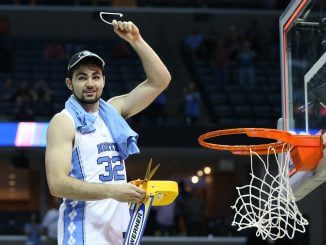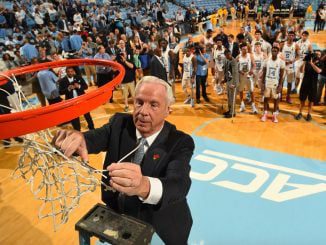
As security searched my bag and I put the lanyard holding my credential around my neck, a towering giant of a man approached the media check-in table. I ran through the legacies on the Tar Heel roster to see what former player this could be. Perhaps Ryan McAdoo’s father, Basketball Hall of Famer Bob?
The UNC dad asked one of the employees manning the table whether any of the concession stands were open. Tipoff was at 6, and his family hadn’t gotten dinner before coming to the game.
“I don’t think so,” came the reply. “We’ve got a skeleton crew tonight.”
I walked away from the table, past aisles blocked off with tape, headed for media seating. We had been instructed to go directly to our seats. The media workroom and dining area were off-limits to us.
It occurred to me that the woman at the check-in table was wrong. This wasn’t a skeleton crew. The skeletons had all been deemed nonessential. This was the last survivor in a zombie movie, reporting to work out of duty and hope, flipping on the light switch in his empty store and hoping the electricity would hold out for one more day.
This was pandemic basketball, the start of the 2020-21 season. For UNC, it was the first game since March 11. That was the night we all found out Tom Hanks had it. So did Rudy Gobert. It was the night the NBA shut down, with some teams quarantined in their locker rooms. That all happened during the Tar Heels’ last game — 259 days ago. This is the longest gap between UNC games since the Heels were eliminated from the 1980 NCAA Tournament on March 9 then opened the 1980-81 season on Nov. 28. That season opener was against Alaska-Anchorage at Buckner Fieldhouse, then home to the Great Alaska Shootout. There were 3,500 fans packed into the building, one-seventh the capacity of the Smith Center.
This year’s opener had 92 people watching at tipoff, all relatives of UNC or Charleston players.
Four of them walked in with me — at a safe social distance, of course. I stumbled across them as they were searching for the one Smith Center entrance still open. They were the only other people outside the building as I approached from the parking lot.
Four people. I usually pass more scalpers, more parking attendants, more student line leaders keeping the undergrads organized. There’s usually a wall of buses out front, and families. Wide-eyed children — or grown-ups — about to attend their first game. There are replica jerseys and ugly blue cardigans. There’s, inexplicably, the smell of waffle cones that seems to hover in a cloud over the building, inside and out. There’s also an air of excitement and anticipation, just as palpable, which also hangs over the building like a cloud.
Instead, as the skies threatened rain, the clouds over the Smith Center had dissipated. It was a lonely building. All activity had ceased.
Inside, things were just as grim. I walked up the stairs to the media seating, grinning behind my mask, ready to greet the usher who had worked the section for the last two years. He read my stuff, which always warms my heart toward a person, and would comment on something I’d said or tweeted since he last saw me. Once, when I spent part of my drive to the game complaining about traffic on social media, he had been keeping up with my struggles on his phone before reporting to his spot.
His spot was empty. He wasn’t there. Neither was his partner, the woman who doesn’t know me from Adam but always smiles anyway.
I reached my seat — three to a row which usually seats 10. A lone bottle of water had been placed at each location.
The Smith Center never seems as big as when it’s empty. The cavernous building swallows all sound. Since the pep band wasn’t in attendance, UNC played a recording of the traditional UNC entrance — a series of rhythmic beats, gradually played faster and faster, until it explodes into the fight song as the team heads out of the tunnel. It sounded tinny and hollow. We could hear the squeaks of sneakers as the team went through its pregame layup line. They seemed to drown out the music.
It all got swallowed up. Something significant was happening, but it was swallowed up by a building that suddenly seems more gray than blue, more lifeless concrete than plastic and metal. The roar of the crowd, the wine and the cheese, all replaced by a single bottle of water and the squeak of sneaker on floor, for a few dozen loved ones to hear.



